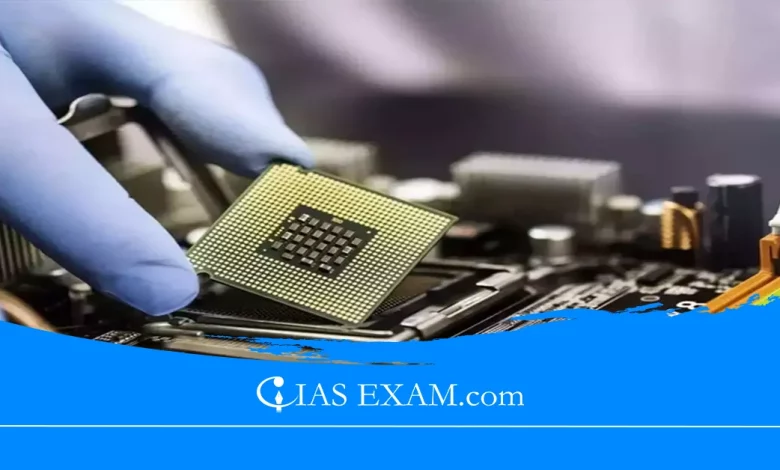Daily Current Affairs for UPSC
India to become a semiconductor manufacturing hub
Syllabus- Economy [GS Paper-3]

Context
Recently it has been argued that India will become a semiconductor manufacturing hub providing huge employment opportunities.
About semiconductor
- A semiconductor is a material product usually composed of silicon.
- It represents a distinct class of materials that possess some of the electrical properties of both conductors and insulators.
- It can be used to control the float of electric currents, and with exquisite precision.
- Each step in semiconductor fabrication needs ultra-high precision and harnesses a mix of diverse scientific principles.
- For instance, to make the most superior transistors, the photolithography technique requires a mild supply emitting electromagnetic radiation at a wavelength of 13.5 nm.
Major players
- Dutch company ASML is the only provider of photolithography machines for modern semiconductor technology worldwide.
- The American companies dominate the software tools the engineers use to layout circuits, at the same time as the silicon wafer sector is led by Japan’s Shin Etsu.
- The market for the actual task of fabrication is led byTaiwan’s TSMC, with fabrication equipment furnished by using Applied Materials and Lam Research, each based in the U.S.
- The majority of intellectual property rights are held by British company Arm.
- The U.S. also imposed sanctions on Chinese tech groups, consisting of bans on the purchase of modern ASML equipment and excessive-stop design software programs, for the same purpose.
- In reaction, China has intensified efforts to bolster its domestic semiconductor manufacturing abilities to fulfill local demand.
Status of India
- India boasts a leading position in chip design centered in Bengaluru.
- However, most of the intellectual property rights required to execute those designs are retained both by dparent companies or by Arm, relegating India to being a mere user of their products.
Benefits
- Computing: The semiconductor industry produces microprocessors and memory chips, which are the primary components in computers, servers, and data centers. These devices are used in various industries, from finance and healthcare to manufacturing and logistics.
- Communications: Semiconductors are used to produce cell phones, satellite structures, and other communication devices. They are also used to create wireless communication systems, network equipment, and other hardware for data transmission.
- Energy: Semiconductors are used in the manufacturing of solar cells and different renewable energy systems. Power management applications additionally use semiconductors, including voltage regulators and electricity power.
- Automotive: Automotive electronics also use semiconductors, which includes engine control units, sensors, and safety systems. They also are utilized in electric automobiles and autonomous vehicles.
- Healthcare: Medical imaging, monitoring, and diagnostic equipment, in addition to medical implants and devices, use semiconductors.
Challenge and Issues
- The semiconductor industry faces the challenges and opportunities of elevated product demand in the near future.
- The increase of artificial intelligence (AI) and the Internet of Things (IoT) and the continued demands from the smartphone sector and different high-tech industries will cause stress on the semiconductor supply chain.
- India also presently lacks in authentic research in semiconductor design, in which the future of the chip is decided.
Recent steps of Government
- The Government of India has launched the India Semiconductor Mission to broaden a complete semiconductor environment, aiming to put India at the leading edge of the global semiconductor industry and bolster youth employment prospects.
- The Union Cabinet recently authorised setting up 3 semiconductor-making units, entailing an funding of Rs 1.26 lakh crore, as part of an try to cut India’s dependence on imports to fulfill the requirements of chips
- Several tasks have been launched to promote semiconductor production, inclusive of the Production Linked Incentive (PLI) scheme for the electronics sector.
Conclusion
- Setting up semiconductor fabrication units or fabs requires significant investments and knowledge.
- India is searching for a collaborative technique, constructing partnerships with like-minded nations to facilitate sustainable growth in the industry.
- India’s expertise pool is exceptional, and the country is presently at an important point where manufacturing can develop hastily and efficiently.
- India has the highbrow ability, determination, and capability to end up a leading worldwide research and development hub.
- It stays targeted on its goal of strengthening the semiconductor industry, which, in turn, will stimulate the growth of the country’s expanding electronics production and innovation environment.
Source: The Hindu





.png)



